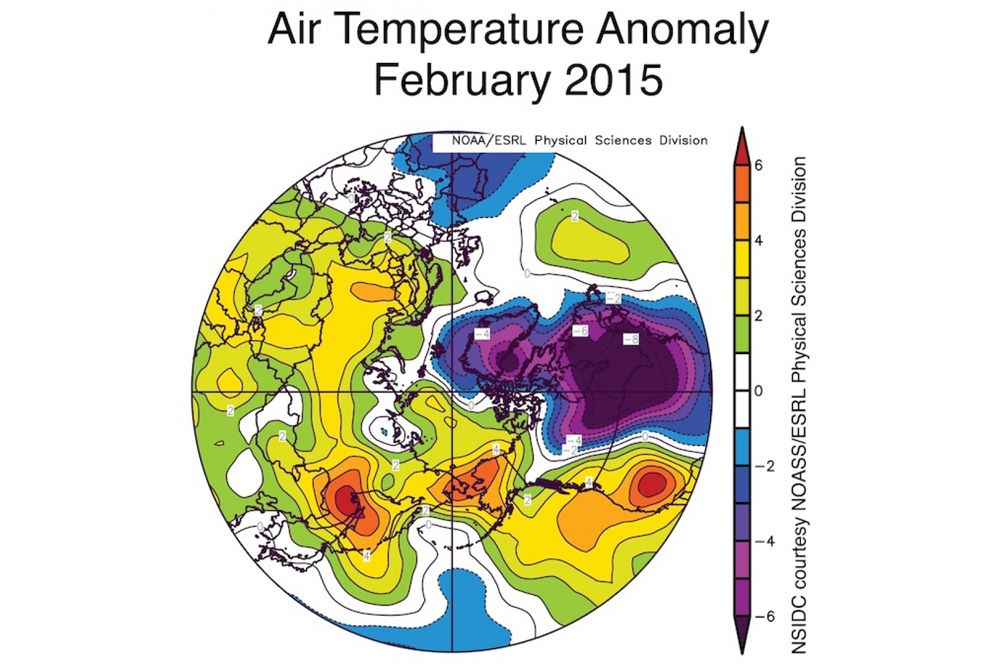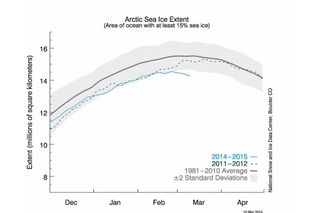Arctic Sea Ice Dwindling Toward Record Winter Low

While balmy hints of spring melt piles of snow in the eastern U.S., the impending end of winter marks peak season for Arctic sea ice. But this year, that winter maximum area is currently on track to hit a record low since satellite records began in 1979.
What that low-ice mark means for the spring and summer melting seasons is unclear, but the milestone would still be notable in the global warming-fueled cycle of Arctic sea ice decline.
“The fact that we're starting the melt season with low — maybe record low — winter extents cannot be good,” Jennifer Francis, a Rutgers University Arctic researcher, said in an email.
Sea ice extent is crucial to the Arctic's ecology and economy, affecting wildlife habitats, weather patterns, and shipping lanes. Sea ice is a key part of the habitats of animals like polar bears and walruses, as well as fish and other creatures that live below it. When it is missing it can make it dififcult for some of the animals to find food.
For humans, ice-free areas of water are prime real estate for oil drilling and shipping and an Arctic low on ice would open the region to more of both, a controversial proposition. There has also been research that indicates the disappearance of sea ice, along with the broader warming of the Arctic, is affecting weather patterns over North America, Europe and Asia, though there is still much work to be done to fully explain such a connection.
The cap of sea ice that covers the Arctic Ocean waxes and wanes with the seasons, with ocean water forming ice as the sun descends below the horizon in the autumn and plunges the region into the perpetual darkness of winter. As the sun re-emerges in spring, the ice can grow no more and melting begins. The ice typically reaches its maximum area in March and its minimum in September.
Arctic Sea Ice Is Getting Thinner, Faster Sea Ice Still Declining, Despite Antarctica’s Gains Watch 28 Years of Old Arctic Ice Disappear in One Minute
Sign up for the Live Science daily newsletter now
Get the world’s most fascinating discoveries delivered straight to your inbox.
Global warming triggers a self-reinforcing downslide in the area the ice covers, as well as how thick the ice is. Warming Arctic temperatures triggered by the buildup of greenhouse gases in the atmosphere cause more ice melt, which exposes more of the open ocean. Whereas the bright white ice reflects the sun’s rays, the dark ocean absorbs them, causing even further warming and melt.
The average extent has declined by 4.52 percent per decade according to the National Snow & Ice Data Center(NSIDC) in Boulder, Colo. The summer minimum has declined even more steeply, by 13.7 percent per decade.
This warming-driven cycle helped lead to 2012’s record low summer sea ice minimum, though what happens year to year is also driven by varying weather patterns.
Those patterns have played a role in shaping this winter’s extent. Temperatures in two areas, the Sea of Okhotsk (on the eastern coast of Russia) and the Bering Sea (between Russia and Alaska), have been 7 to 11°F above normal, keeping ice levels there well below normal. That heat is part of a broader area of unusually warm temperatures that extends from Europe across Asia and down through the western U.S.

With that area so far below normal, overall Arctic sea ice extent sits well below the average range for this time of year. There’s still time for a late-March surge in sea ice formation, as has happened in recent winters, said Julienne Stroeve of the NSIDC, but ocean temperatures are too warm to make that likely.
That means there’s a good chance sea ice area will stay at a record-low level as it begins its warm season retreat.
What that might mean for summer and any potential new record low at the end of that season is unclear, as research and observations have shown that winter area isn’t always a good indicator of how the summer will unfold.
“Winter maximum tends to have little influence on the summer minimum as we've seen in previous record low years,” Stroeve said.
But if sea ice levels don’t surge and instead begin to drop off or stay flat, that would indicate the winter maximum occurred earlier than normal, and “this is also bad news because it means that the melt season will be longer, allowing more opportunity for ice to melt,” Francis said.
You May Also Like: Four Countries Eclipse EU Renewable Goals Early CO2 Boosts Trees, But Ups Damage From Forest Pests Artificial Photosynthesis Closer to Boosting Renewables Sao Paulo’s Reservoirs Feel Pinch of Failed Wet Season
Original article on Climate Central.

Andrea Thompson is an associate editor at Scientific American, where she covers sustainability, energy and the environment. Prior to that, she was a senior writer covering climate science at Climate Central and a reporter and editor at Live Science, where she primarily covered Earth science and the environment. She holds a graduate degree in science health and environmental reporting from New York University, as well as a bachelor of science and and masters of science in atmospheric chemistry from the Georgia Institute of Technology.












